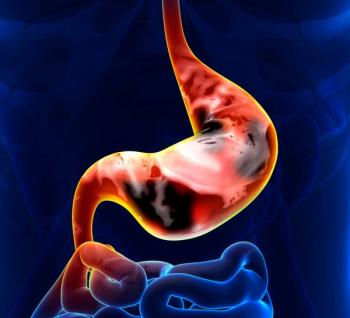
Lower-Risk MDS Population Has Enduring RBC-TI Following Imetelstat Therapy
Data from the IMerge trial affirm the enduring responses and clinical benefit with imetelstat in those with transfusion-dependent MDS.
Patients with lower-risk transfusion-dependent myelodysplastic syndrome (MDS) experienced sustained red blood cell transfusion independence (RBC-TI) without a detriment in overall survival (OS) following treatment with imetelstat (Rytelo), according to updated results from the phase 3 IMerge study (NCT02598661) presented at the
In total, 83% of patients who responded to imetelstat (n = 47) achieved a single continuous RBC-TI period of at least 8 weeks. The median duration of RBC-TI was 51.6 weeks (95% CI, 26.9-80.4) among responders in the imetelstat arm vs 13.3 weeks (95% CI, 8.0-24.9) among responders in the placebo arm (n = 9).
Among patients in the imetelstat arm who achieved RBC-TI for at least 8 weeks, at least 24 weeks, and at least 1 year after treatment initiation, the median durations of RBC-TI were 52 weeks, 80 weeks, and 132 weeks, respectively. Seventy percent of patients in the imetelstat arm who achieved RBC-TI for at least 8 weeks went on to have RBC-TI for at least 24 weeks, and 64% of patients in the imetelstat arm who achieved RBC-TI for at least 24 weeks went on to have RBC-TI for at least 1 year.
“The data indicate clearly that the majority of patients responding to imetelstat do have a very durable response, and the…clinical benefit is clear,” lead study author Valeria Santini, MD, said in the presentation.
Santini is an associate professor of hematology at the University of Florence Medical School in Italy.
Imetelstat Emerges in the MDS Armamentarium
On June 6, 2024, the FDA approved imetelstat for the treatment of adult patients with low-to intermediate-1–risk MDS and transfusion-dependent anemia requiring at least 4 RBC units over 8 weeks who have lost response to, not responded to, or are not eligible for erythropoiesis-stimulating agents (ESAs).2 This regulatory decision was based on prior findings from the IMerge trial. The primary analysis of IMerge demonstrated significantly higher rates of RBC-TI at least 8 weeks, at least 24 weeks, and at least 1 year after initiating treatment with imetelstat (n = 118) vs placebo (n = 60), at 39.8% (95% CI, 30.9%-49.3%), 28.0% (95% CI, 20.1%-26.6%), and 17.8%, respectively, vs 15.0% (95% CI, 7.1%-26.6%; P < .001), 3.3% (95% CI, 0.4%-11.5%; P < .001), and 1.7%, respectively, in the intention-to-treat (ITT) population.1,2 The most common adverse effects observed with imetelstat were thrombocytopenia and neutropenia, which were generally resolvable to grade 2 or below and were manageable with dose modifications.
The IMerge Trial Design Invites Further Insights
The double-blind, randomized IMerge trial was conducted at 118 clinical sites across 17 countries.1 This trial enrolled 178 patients with International Prognostic Scoring System (IPSS) low- or intermediate-1–risk MDS who had relapsed on or were refractory to ESAs (or erythropoietin administered at a dose greater than 500 mU/mL if they were ineligible for ESAs). Patients were eligible if they required at least 4 units of RBC transfusions every 8 weeks across 16 weeks prior to the study. Patients were not permitted to enroll if they had deletion 5q or had received prior treatment with lenalidomide (Revlimid) or hypomethylating agents.
Patients were randomly assigned 1:1 to receive either imetelstat at 7.1 mg/kg every 4 weeks or placebo. Stratification factors included transfusion burden (4-6 units vs >6 units) and IPSS risk category (low vs intermediate-1). Supportive care, including platelet and RBC transfusions, myeloid growth factors, and iron chelation therapy, was administered as needed during the study per investigator discretion.
RBC-TI at least 8 weeks from the start of study treatment served as the trial’s primary end point. Key secondary end points included RBC-TI at least 24 weeks from the start of study treatment, duration of RBC-TI, hematologic improvement–erythroid, and safety. Other secondary end points included OS, progression-free survival (PFS), and time to progression to acute myeloid leukemia (AML). Key exploratory end points included changes in variant allele frequency or somatic mutations, cytogenetic response, and patient-reported outcomes.
Hemoglobin Levels Appear to Normalize in Long-Term Imetelstat Responders
Santini noted that baseline characteristics were well balanced between the 2 arms. Most patients in each arm (62%) had ring sideroblast (RS)–positive MDS; patients with this subtype tend to live longer and therefore require more transfusions than those with RS-negative disease, she explained.
The rates of patients who achieved RBC-TI with a concurrent hemoglobin increase of at least 1.5 g/dL were higher among patients in the imetelstat arm vs the placebo arm. Among patients in the imetelstat arm who achieved RBC-TI for at least 8 weeks, at least 24 weeks, and at least 1 year, the median durations of RBC-TI with a hemoglobin rise of at least 1.5 g/dL were 28%, 23%, and 17%, respectively, vs 2% (P < .001), 0% (P < .001), and 0% (P < .001), respectively, in the placebo arm.
Furthermore, responders in the imetelstat arm had higher median hemoglobin peaks vs those in the placebo arm. Among patients in the imetelstat arm who achieved RBC-TI for at least 8 weeks, at least 24 weeks, and at least 1 year, the median hemoglobin peaks were 11.3 g/dL (n = 47), 12.1 g/dL (n = 33), and 13.1 g/dL (n = 21), respectively, vs 8.9 g/dL (n = 9), 8.4 g/dL (n = 2), and 7.9 g/dL (n = 1), respectively, in the placebo arm.
Imetelstat Yields No Survival Detriment
Treatment with imetelstat did not lead to an OS detriment vs placebo in the ITT population. As of January 2024, 47% of patients in the imetelstat arm and 43% of those in the placebo arm were in follow-up. At respective median durations of follow-up of 32 months and 28 months, the median OS was 40.4 months with imetelstat vs not evaluable (NE) with placebo (HR, 0.98; 95% CI, 0.53-1.82).
In the imetelstat arm, the median OS was 40.4 months among patients who achieved RBC-TI for at least 8 weeks vs NE among non-responders (HR, 0.78; 95% CI, 0.40-1.52). At 2 years, the OS rates were 81% among patients who achieved RBC-TI for at least 8 weeks with imetelstat, 75% among patients who did not respond with imetelstat, and 74% among patients in the placebo group.
A total of 24.6% and 23.3% of patients experienced PFS events in the imetelstat and placebo arms, respectively. The median PFS was NE in both the imetelstat (95% CI, 29.2 months–NE) and placebo (95% CI, 16.7 months–NE) arms (HR, 0.85; 95% CI, 0.44-1.64; P = .631). Eleven percent and 13.3% of patients in the imetelstat and placebo arms, respectively, had disease progression; 1.7% and 3.3% of patients in these respective arms had progression to AML (HR, 0.45; 95% CI, 0.06-3.23; P = .418).
“More studies will be needed to clarify the mechanism of action [of imetelstat] and the possibility to obtain longer response,” Santini concluded.
References
- Santini V, Komrokji RS, Sekeres MA, et al. Overall survival, clinical benefit, and durable transfusion independence with imetelstat in the IMerge phase 3 trial of red blood cell transfusion-dependent lower-risk myelodysplastic syndromes. Presented at: 2024 SOHO Annual Meeting; September 4-7, 2023; Houston, TX. Abstract MDS-157.
- FDA approves imetelstat for low- to intermediate-1 risk myelodysplastic syndromes with transfusion-dependent anemia. FDA. June 6, 2024. Accessed September 5, 2024. https://www.fda.gov/drugs/resources-information-approved-drugs/fda-approves-imetelstat-low-intermediate-1-risk-myelodysplastic-syndromes-transfusion-dependent
Newsletter
Stay up to date on recent advances in the multidisciplinary approach to cancer.


















































































